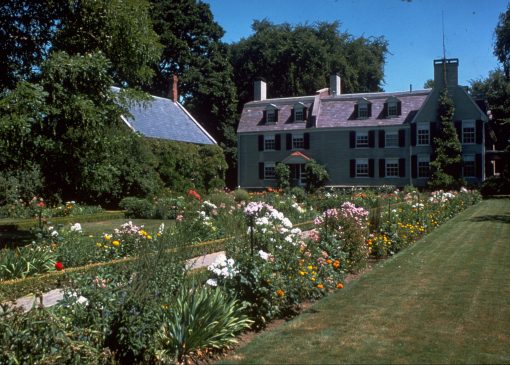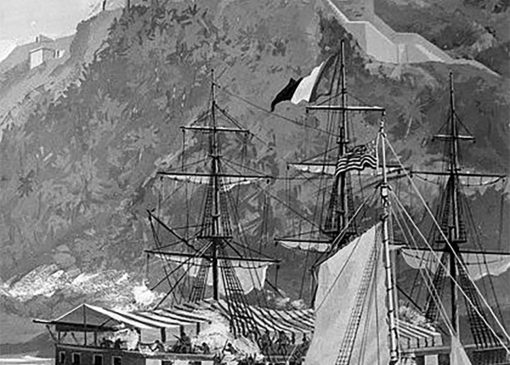*Editor’s Note: Chronicles of an American Diplomat: John Quincy Adams is a series following John Quincy Adams from his education at his father’s side through the American Founding Period through to his own official embarkment on a diplomatic career, and the events that transpired during the era that he had to navigate. We know much of John Quincy Adams, and his times, from his massive writings, which collectively constitute an American Classic. This offers a chronicle of the opening of his public career from 1794-1801. The following is the fourth post in the series.
~*~*~*~
In Dispatch #3 covering July 13-August 8, 1794, John Quincy Adams continued to work through the diplomatic records in the State Department archives in preparation for his upcoming assignment as American minister to the Netherlands. This included an examination of his father’s correspondence when serving in Europe, including his conflicts with Benjamin Franklin and French officials. Finally, JQA received his instructions from Secretary of State Randolph and Treasury Secretary Alexander Hamilton. He was to ordered to mange the existing financial obligations of the United States in Europe, and if possible, to facilitate a new loan of 800,000 dollars, in order both to ransom Americans held captive by the Dey of Algiers, and also to obtain peace with that Barbary leader. JQA was also to ensure that commercial relations between the Netherlands and the United States remained on a positive footing.
In general terms, JQA was instructed to provide the State Department with intelligence about changes in Dutch government and policy; about significant alterations in the strategic situation in Europe; and about developments relating to the emergence of an armed neutrality among the non-belligerents. As he was preparing to travel northward to arrange passage to Europe, he heard news of an uprising in western Pennsylvania, known to history as the Whiskey Rebellion.
~*~*~*~
Saturday, August 9, 1794. John Quincy arrived in New York City at six in the evening, after an overnight and all day stage ride. He took up lodging at his sister’s house, feeling quite unwell. He had been instructed by Secretary of State Randolph to remain there to receive last minute dispatches for special envoy John Jay in London, once John Quincy arranged passage from either New York or Boston.[1]
Sunday, August 10-Wednesday August 13. Still feeling unwell, he engaged in the usual round of visits and dinners. He had “a very long & interesting conversation” (on which he did not elaborate) with General Horacio Gates, a controversial Revolutionary War soldier who had run afoul of George Washington. Gates was now living in Manhattan, having moved with his second wife from his Virginia plantation. Unverified stories circulated later that in 1790 John Adams had persuaded Gates to free his slaves, although the story of their emancipation is more complicated. But John Adams certainly had considered Gates to be a friend. It was one of the reasons that Washington had been suspicious of the elder Adams’s loyalty.[2]
Thursday, August 14, 1794. John Quincy received a private letter from Randolph, enclosing a credit of 3,000 dollars to be drawn upon from the Boston branch of the Bank of the United States; and letters to be provided to John Jay and the regular minister to Britain, Thomas Pinckney. “The news from westward [on the Whiskey Rebellion] is hourly expected but it is extremely uncertain whether the insurgents will receive our commissioners,” Randolph wrote. “The further dispatches, which I wished to send to you at New York, must be deferred for the next mail to Boston; as it is all important, that you should carry to Europe a precise account of the insurrection.”
The American government was clearly concerned that unfounded rumors about the extent of the violence would spread to Europe and complicate or defeat Jay’s diplomatic efforts. Although Randolph did not say so, President Washington himself was prepared to lead a militia force against the rebels if the negotiations to gain their submission failed.
John Quincy acknowledged receipt of the letter and returned a provisional check Randolph had given him before leaving Philadelphia. As he could not find immediate passage to any part of Europe from New York, he informed the secretary that he planned to depart for Boston the following day, and expected to be there by August 20, if there were any further orders. He raised a question that he had forgotten to ask before leaving the capital — what to do with the American embassy at The Hague. Although he did not mention it, John Adams had purchased and furnished a house for that purpose in 1781, and John Quincy had lived in it occasionally. Was he to take charge of it and was he authorized to sell?[3]
Friday, August 15- Tuesday, August 19, 1794. After another day of waiting, John Quincy took passage on the packet Sally out of Providence, headed for home with his brother Charles, who was going to visit their parents in Quincy. They took the stage from Providence to Walpole, Dedham, and finally to Boston.[4]
Wednesday, August 20-Sunday, August 24, 1794. Back and forth between Boston and Quincy, still looking for passage to Europe.[5]
Monday, August 25, 1794. John Quincy received a note from a government clerk with additional letters from Randolph to carry to Europe. He responded that he was still trying to arrange passage, and hoped to do so within the next three weeks from Boston or New York. He reported that he could still take new dispatches if they were ready before then.[6]
Tuesday, August 26-September 8, 1794. John Quincy marked the time by shuttling back and forth between farewell dinners in Boston and weekends in Quincy.[7]
September 9, 1794. John Quincy had enough of the waiting. He booked passage on the merchant ship Alfred, despite its dubious reputation of seaworthiness. He did so reluctantly — in his first crossing to Europe as a child, his ship had endured a horrible Atlantic winter storm. On his second voyage, that ship developed a serious leak and all hands, John Quincy included, were called for duty to man the pumps. They barely limped into port in Spain, far short of their destination in France.[8]
September 10, 1794-September 16, 1794. John Quincy made last minute preparations to sail, and said goodbye to family and friends. “I once more wish you a prosperous Voyage and honourable Conduct and a happy Life,” John Adams wrote to his sons. “Remember your Characters as Men of Business as well as Men of Virtue, and always depend on the Affection and Friendship of your Father.” He gave John Quincy an order, to be placed with the Amsterdam Bankers, transferring 15 one thousand-guilder coupons of obligations he held on the U.S. loan from his own account there. The securities paid five percent interest. He gave five coupons to each of his three sons, a handsome gift of approximately two thousand dollars and a financial hedge for John Quincy and Thomas if they were hard pressed while in Europe. The American minister to The Hague thus acquired a small personal stake in the international financial credit of the United States. Abigail, for her part, undoubtedly warned her sons, especially the easily smitten Thomas, to avoid the charms of Dutch girls. She made it clear that she did not want either of them to drag a European wife back to America.[9]
September 17, 1794. “Sailed for London 10 A.M. Ship Alfred.” He was accompanied by his brother Thomas, and by his servant Tilly Whitcomb. His friends, Nathaniel Frazier and Daniel Sargent, went onboard and sailed to the lighthouse in Boston Harbor before being rowed back to town. Frazier told him: “You depart on the day of Virtue,” alluding to the new French calendar, “I hope you will return on the day of Rewards.” John Quincy recorded in his journal: “The pain of separation from my friends and country was felt as poignantly by me, at the moment when these two young men left the ship, as it has ever been at any period of my life. It was like severing the last string from the heart. I looked back at their boat, as long as it could be seen, and when it had got out of sight, I did not, but I could have, turned my eye and wept.”[10]
~*~*~*~
A Note About the Construction: In attempting to provide chronicles of John Quincy’s early diplomatic career, we utilize his daily diary (journal) entries as the foundation, but group these and other material so as to provide a coherent narrative, while still retaining an “as it happened” framework. For instance, he often reflects on events, and the contents of letters and documents, days after they occurred or were received. We provide footnotes to give the reader an accurate account of the sources and their dates.
Primary Sources
APM — Adams Family Papers, Microfilm Edition, Massachusetts Historical Society, with Reel Number. The indicated transcripts were prepared from this source.
DJQA — Diary, from the Memoirs of John Quincy Adams,
comprising portions of his diary from 1795 to 1848, edited by Charles Francis Adams, volume 1.
FOL — Founders Online, National Archives https://founders.archives.gov
LD/SE — Line-a-day and short entries from his diary, APM, and available online through the Massachusetts Historical Society. http://www.masshist.org/jqadiaries/php/ The indicated transcripts were prepared from this source.
WJQA — Writings of John Quincy Adams, edited by Worthington C. Ford.
[1] August 9, 1794, LD/SE; JQA (New York) to TBA, August 13, 1794, APM 126.
[2] Entries for the dates indicated, LD/SE; Gene Procknow, “Slaves Through the Eyes of Revolutionary Generals,” Journal of the American Revolution (November 7, 2017).
[3] Randolph (Philadelphia) to JQA, August 13, 1794, APM 377 (private); JQA (New York) to Randolph, August 14, 1794, APM 127.
[4] Entries for these dates, LD/SE.
[5] Entries for these dates, LD/SE.
[6] Wagner (Philadelphia) to JQA, August 18, 1794, APM 377; JQA (Boston) to Randolph, August 25, 1794, APM 127.
[7] Entries for these dates, LD/SE.
[8] September 8, 9, 1794, LD/SE.
[9] Entries for these dates, LD/SE; JA (Quincy) to JQA and TBA, September 14, 1794, FOL; JQA (Amsterdam) to Charles Adams, November 20, 1794, FOL.
[10] September 17, 1794, LD/SE and DJQA; JQA (The Hague) to John Gardner, July 15, 1795, APM 128.




